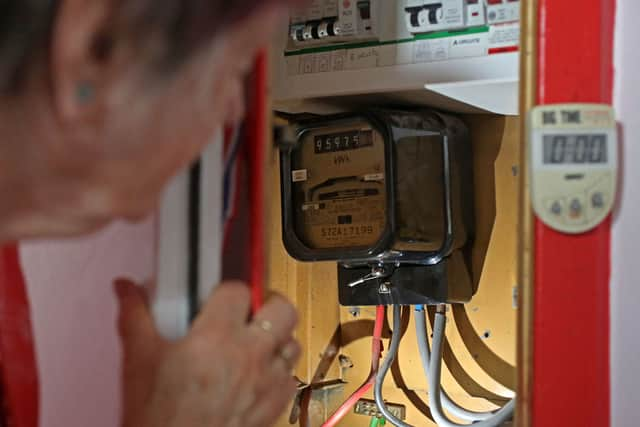Energy meter readings: households urged to make Easter energy meter readings to save as prices drop on 1 April
and live on Freeview channel 276
Around 10 million households are being urged to submit their energy meter readings to their supplier this weekend, to ensure they avoid overpaying when lower prices take effect on 1 April.
Starting next month, the average household energy bill is set to reach its lowest point in two years, following Ofgem's decision to lower the price cap in response to wholesale prices.
Advertisement
Hide AdAdvertisement
Hide AdThe energy regulator is reducing the price cap by 12.3%, which will mean that for a typical dual fuel household in England, Scotland and Wales, the cap will drop from the current £1,928 to £1,690.
Over the span of a year, this translates to a decrease of £238, or approximately £20 per month.
Ben Gallizzi, energy spokesman at Uswitch.com, said: “We urge any households without a smart meter to submit their meter readings this bank holiday weekend, so their supplier has an updated and accurate view of your account on or around 1 April.
“This is when the next energy price cap comes into effect, which will see the rates that households on standard variable tariffs pay for their energy fall for April, May and June.
Advertisement
Hide AdAdvertisement
Hide Ad"If you delay submitting your readings, some of your energy usage could end up being charged under the higher rates we’re currently facing. All households without a smart meter should ideally submit a meter reading every month to improve the accuracy of their bills.”
How much could I save?


The average household on a standard variable tariff (SVT) is expected to spend £127 on energy in April, compared with £205 in March, due to a combination of cheaper rates and lower usage as the weather warms up.
Those on SVTs who do not have a smart meter and do not submit meter readings on or around 1 April risk having some of their usage after that date charged at the previous, more expensive rates.
Advertisement
Hide AdAdvertisement
Hide AdThe difference between a week’s worth of energy at the old rates compared with a week in April was £4.65 for the average household, Uswitch warned.
Suppliers who have not received meter readings base their bills on estimated usage, meaning households could be overpaying, while others may not be paying enough.
How to read your meter
Understanding how to read your gas and electricity meters is essential for managing your energy usage and ensuring accurate billing.
Many smart meters are designed to automatically send readings to your energy supplier, eliminating the need for manual readings, but you can still obtain a manual reading to ensure they have done their job accurately.
Advertisement
Hide AdAdvertisement
Hide AdSmart meters come with an In-Home Display that shows real-time energy usage in pounds and pence. You can navigate through different screens to view usage over various time periods.
Many energy suppliers offer apps or online portals where you can track your energy usage in detail, including historical data and projections.
Smart meters may display usage in kWh (kilowatt-hours) for electricity and cubic meters (m³) for gas. Familiarise yourself with these units to better understand your energy consumption.
For those with older, more traditional meters, regular manual readings may be required. Gas meters are typically located outside your property, often on an external wall, and usually resemble a metal box with a series of dials or digital displays.
Advertisement
Hide AdAdvertisement
Hide AdOn traditional gas meters with dials, start from left to right, noting down the number closest to the pointer on each dial. If the pointer is between two numbers, record the lower number.
Some meters have a decimal point or half-digit dial. If present, include the value of this digit in your reading - note down the numbers you've recorded from each dial, ensuring accuracy.
Electricity meters are usually found inside your property, often in a cupboard or under the stairs, and can be digital or analogue.
For digital meters, simply note down the numbers displayed on the screen. Some meters may have multiple displays for different rates, such as day and night readings.
Advertisement
Hide AdAdvertisement
Hide AdAnalog meters have a series of dials, similar to gas meters. Start from left to right, noting the number closest to the pointer on each dial. Again, record the lower number if the pointer falls between two digits.
Similar to gas meters, some electricity meters have a half-digit dial or decimal point. Include this in your reading if applicable.
Comment Guidelines
National World encourages reader discussion on our stories. User feedback, insights and back-and-forth exchanges add a rich layer of context to reporting. Please review our Community Guidelines before commenting.
